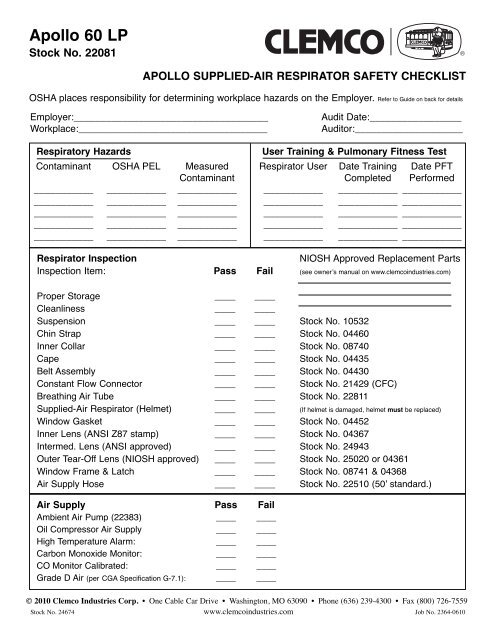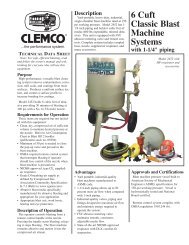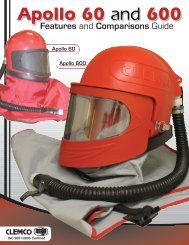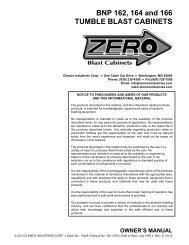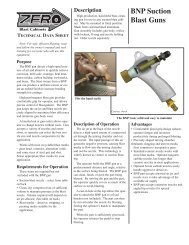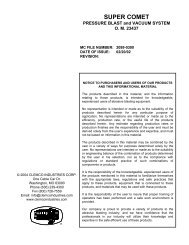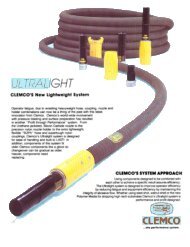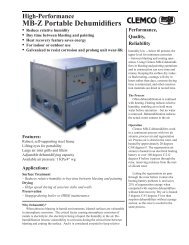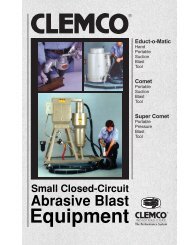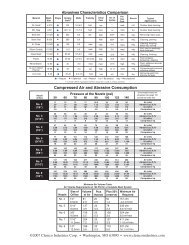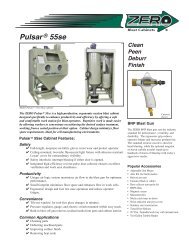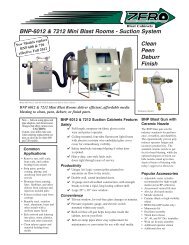24674 - Apollo 60 LP - Clemco Industries Corp.
24674 - Apollo 60 LP - Clemco Industries Corp.
24674 - Apollo 60 LP - Clemco Industries Corp.
Create successful ePaper yourself
Turn your PDF publications into a flip-book with our unique Google optimized e-Paper software.
<strong>Apollo</strong> <strong>60</strong> <strong>LP</strong><br />
Stock No. 22081<br />
APOLLO SUPPLIED-AIR RESPIRATOR SAFETY CHECKLIST<br />
OSHA places responsibility for determining workplace hazards on the Employer. Refer to Guide on back for details<br />
Employer:____________________________________<br />
Workplace:___________________________________<br />
Audit Date:_________________<br />
Auditor:____________________<br />
Respiratory Hazards<br />
User Training & Pulmonary Fitness Test<br />
Contaminant OSHA PEL Measured Respirator User Date Training Date PFT<br />
Contaminant Completed Performed<br />
___________ ___________ ___________ ___________ ___________ ___________<br />
___________ ___________ ___________ ___________ ___________ ___________<br />
___________ ___________ ___________ ___________ ___________ ___________<br />
___________ ___________ ___________ ___________ ___________ ___________<br />
___________ ___________ ___________ ___________ ___________ ___________<br />
Respirator Inspection<br />
NIOSH Approved Replacement Parts<br />
Inspection Item: Pass Fail (see owner’s manual on www.clemcoindustries.com)<br />
Proper Storage ____ ____<br />
Cleanliness ____ ____<br />
Suspension ____ ____ Stock No. 10532<br />
Chin Strap ____ ____ Stock No. 044<strong>60</strong><br />
Inner Collar ____ ____ Stock No. 08740<br />
Cape ____ ____ Stock No. 04435<br />
Belt Assembly ____ ____ Stock No. 04430<br />
Constant Flow Connector ____ ____ Stock No. 21429 (CFC)<br />
Breathing Air Tube ____ ____ Stock No. 22811<br />
Supplied-Air Respirator (Helmet) ____ ____ (If helmet is damaged, helmet must be replaced)<br />
Window Gasket ____ ____ Stock No. 04452<br />
Inner Lens (ANSI Z87 stamp) ____ ____ Stock No. 04367<br />
Intermed. Lens (ANSI approved) ____ ____ Stock No. 24943<br />
Outer Tear-Off Lens (NIOSH approved) ____ ____ Stock No. 25020 or 04361<br />
Window Frame & Latch ____ ____ Stock No. 08741 & 04368<br />
Air Supply Hose ____ ____ Stock No. 22510 (50’ standard.)<br />
Air Supply Pass Fail<br />
Ambient Air Pump (22383) ____ ____<br />
Oil Compressor Air Supply ____ ____<br />
High Temperature Alarm: ____ ____<br />
Carbon Monoxide Monitor: ____ ____<br />
CO Monitor Calibrated: ____ ____<br />
Grade D Air (per CGA Specification G-7.1): ____ ____<br />
© 2010 <strong>Clemco</strong> <strong>Industries</strong> <strong>Corp</strong>. • One Cable Car Drive • Washington, MO 63090 • Phone (636) 239-4300 • Fax (800) 726-7559<br />
Stock No. <strong>24674</strong> www.clemcoindustries.com Job No. 2364-0610
APOLLO SUPPLIED-AIR RESPIRATOR SAFETY GUIDE<br />
Respirator use requires the oversight of personnel competent in the field of Environmental Health and Safety. Employers must always fully<br />
understand the health and safety risks to every employee, implement all applicable safety measures required by good engineering practice,<br />
and follow federal, state, and local regulations. The Employer is responsible for an employee's full understanding of workplace hazards.<br />
Determining Respiratory Hazards:<br />
The first step is to determine if a respirator is required. The Occupational Safety and Heath Administration (OSHA) publishes a list of<br />
Permissible Exposure Limits (PELs) for hazardous contaminants. The National Institute of Occupational Safety and Health (NIOSH) and<br />
the American Conference of Government Industrial Hygienists (ACGIH) play a major role in identifying these contaminants and the level at<br />
which they are hazardous.<br />
The best method to determine work place hazards is to have a Certified Safety Professional (CSP) or a Certified Industrial Hygienist (CIH)<br />
assess the work environment. The following websites list consultants:<br />
http://www.assedirectory.com/disclaimer.asp<br />
http://www.aiha.org/Content/AccessInfo/consult/consultantsearch.htm<br />
A list of Hazardous Materials regulated by OSHA can be found at:<br />
http://www.osha.gov/pls/oshaweb/owadisp.show_document?p_table=STANDARDS&p_id=10147<br />
If the competent professional determines the need for a respirator, a Job Hazard Analysis (JHA) must be completed. Instructions on how to<br />
perform this analysis can be found at:<br />
http://www.osha.gov/pls/publications/pubindex.list<br />
Once all job site hazards have been identified and a Job Hazard Analysis completed, the next step is selecting a respirator.<br />
Selecting a Respirator:<br />
NIOSH publishes a manual, used by OSHA to assess the adequacy of respirators employers choose. The NIOSH manual provides a<br />
systematic way to select a respirator. The NIOSH Respirator Selection Logic can be found at:<br />
http://www.cdc.gov/niosh/docs/2005-100/<br />
Once the appropriate respirator has been selected, the employer must create a detailed Respiratory Protection Program. The federal<br />
standard, which governs this regulation, can be found at:<br />
http://www.osha.gov/pls/oshaweb/owadisp.show_document?p_table=STANDARDS&p_id=12716<br />
This website directs the employer to the Industry Standard for Respiratory Protection. The Construction standard (CFR29-1926.103) and<br />
the Maritime standard (CFR29-1915.154) refer the employer to the General Industry Standard at the website listed above.<br />
For additional help in developing a compliant Respiratory Protection Program, OSHA provides a manual found at:<br />
http://www.osha.gov/pls/publications/pubindex.list<br />
Included in the Respiratory Standard is the requirement for training the respirator user and performing an annual Pulmonary Fitness Test.<br />
Local occupational medical professionals can perform this test.<br />
Maintaining the <strong>Apollo</strong> Respirator:<br />
While the <strong>Apollo</strong> supplied-air respirator may be used in many applications, its primary use is for respiratory protection during abrasive<br />
blasting. <strong>Apollo</strong> respirators have been tested and approved for abrasive blasting by NIOSH, as required by OSHA. Only original <strong>Apollo</strong><br />
parts may be used to repair the <strong>Apollo</strong> respirator. Substitution of non-approved parts voids the NIOSH approval and violates OSHA<br />
regulations.<br />
<strong>Clemco</strong> provides inspection and cleaning instructions in the owner’s manual provided with the respirator. If this manual is lost, it can be<br />
found at:<br />
http://www.clemcoindustries.com/o_m.php?cat_id=5<br />
Maintaining the Sorbent Bed Filter:<br />
OSHA regulations, 29CFR1910.134(i)(5)(iii), require the use of a sorbent bed or filter to further ensure breathing air quality. <strong>Clemco</strong>’s CPF<br />
Air Filter satisfies this requirement. The CPF removes objectionable mist and odors from the breathing air; its replaceable filter element<br />
becomes ineffective with use. The employer shall change this filter on a regular basis, depending on its use. A manual is provided with the<br />
CPF filter. This manual also is available at:<br />
http://www.clemcoindustries.com/o_m.php?cat_id=5<br />
Grade D Air Requirement:<br />
OSHA sets the breathing-air standard for <strong>Apollo</strong> respirators in 29CFR 1910.134(i). This standard includes use of Carbon Monoxide<br />
Monitors in the air-supply stream coming from oil-lubricated compressors. <strong>Clemco</strong> offers Carbon Monoxide Monitors. These monitors must<br />
be cleaned and calibrated on a documented regular basis. The owner's manual provides cleaning and calibration instructions. This manual<br />
is available at:<br />
http://www.clemcoindustries.com/o_m.php?cat_id=5<br />
©2010 <strong>Clemco</strong> <strong>Industries</strong> <strong>Corp</strong>., Washington, MO 63090 Tel: 636 239-4300 Fax: 800 726-7559


